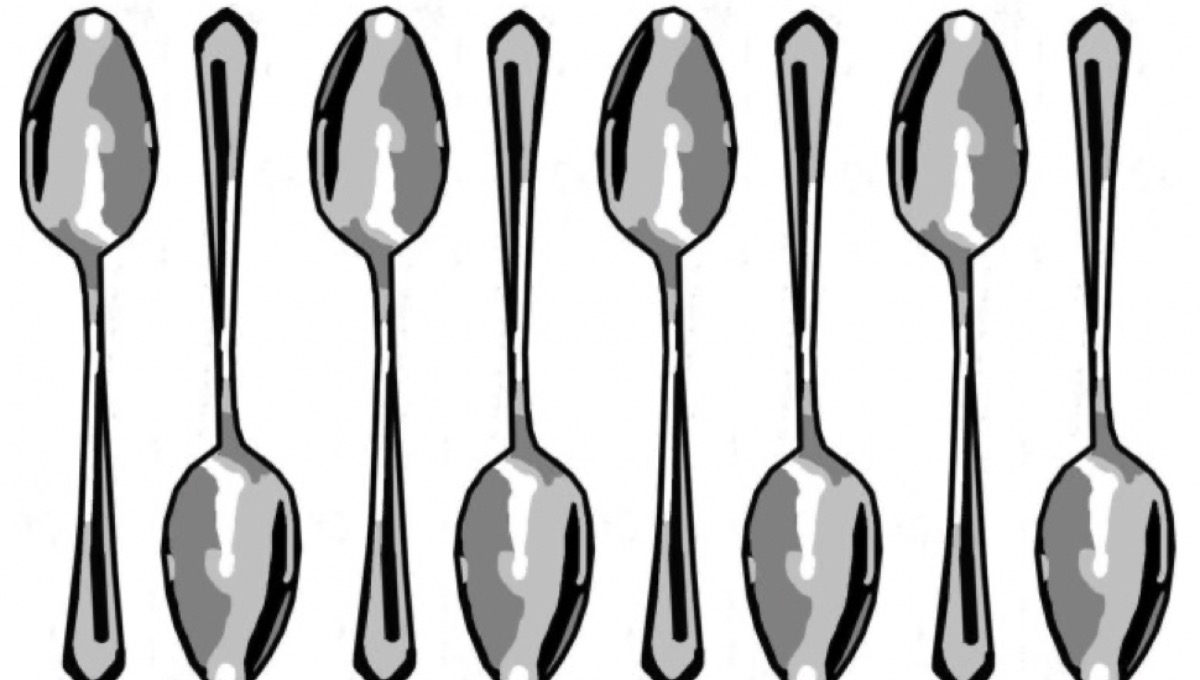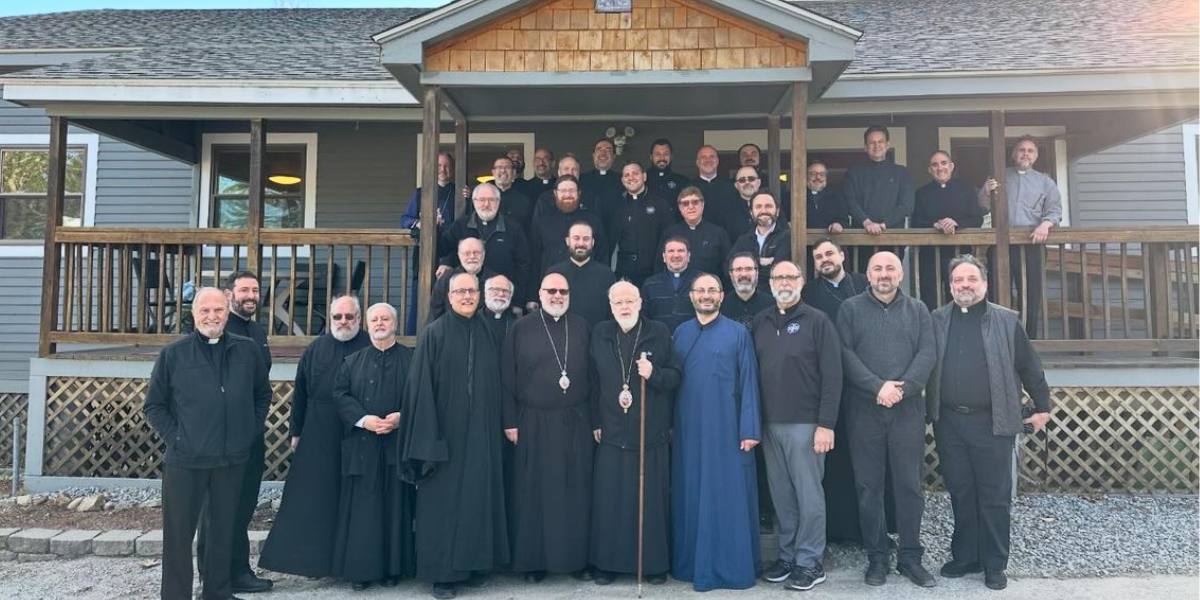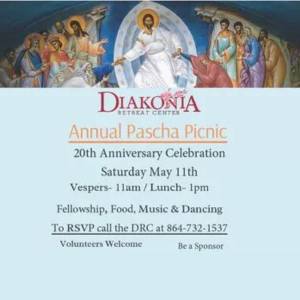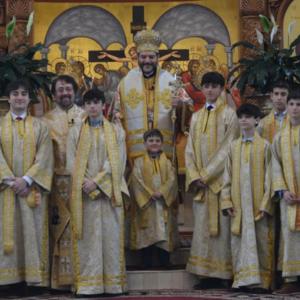From One Spoon to Many
Since the beginning of the Covid-19 pandemic, the Orthodox Church has found itself in an existential crisis. The situation has challenged our traditions and even the way that we receive Holy Communion. One of the points of disagreement that has arisen concerns the manner in which Holy Communion is distributed to the faithful from the common cup by means of a common spoon.
The experience of the church tells us that Holy Communion by the common spoon never became a vector to transmit disease. Many priests have consumed a Consecrated Lamb that had molded due to natural conditions. In addition, every priest, after distributing communion with the spoon to the people, has consumed the remaining Gifts with that same spoon at the conclusion of the Liturgy; yet priests who have served in hospitals specialized in infectious diseases can tell you that no one ever got sick- from tuberculosis, AIDS, herpes, influenza, and even Ebola (as we hear from our brothers who serve in Africa).
Nevertheless, many of the faithful have always been fearful or disgusted by the common spoon. We can spend countless hours explaining sociologically the reasons behind it, but that is not our purpose today. We just need to accept this reality. So, the question is how do we continue to minister to people who struggle with this fear? Do we throw them out of the Church, admonishing them for their lack of faith? Or, do we follow the path of the Lord and embrace them? Are we not called to follow the example of the Good Shepherd, who leaves his flock of ninety-nine sheep in order to find the one which is lost and who tells us “Go and learn what this means: ‘I desire mercy, not sacrifice.’ For I have not come to call the righteous, but sinners” (Matthew 9:13) and that “The Sabbath was made for man, not man for the Sabbath (Mark 2:27)”?
All around the world, local Orthodox churches have adopted different ways to respond to this current crisis. One of these responses has been to implement multiple metal, non-disposable spoons for communion.
Remember that the introduction of the single spoon in the 11th century was not only a novelty, it was an innovation against the traditional way given to us by Christ Himself at the Mystical Supper and practiced by the apostolic church For over a thousand years, the faithful received communion in the hand and each gift separately, which is the manner in which the clergy receive Holy Communion to this day. Even though this change in practice was not adopted officially by any council or by a patriarch or any other high church dignitary, it seems that it had the backing of influential groups within the church. Some, like Vlasios Fidas, a church historian, point out the Studites endorsing the practice, having received it originally from the Monasteries of the Un-Sleeping (Μονές των Ακοιμήτων).
Anyone interested in the liturgical and historical details can read about that from Fr. Robert F. Taft, SJ (The Liturgy of St. John Chrysostom. A History, Vol. VI), or in the most recent articles of Fr. Alkiviadis Calivas and Professor Panagiotis Skaltsis. It is clear from all these works that practical and pastoral reasons led to the introduction of the spoon and that the way of distributing communion, always, was adopted according to the needs of the faithful.
In a recent article, Dr. Eugenia Constantinou responds to Fr. Alkiviadis Calivas by offering a synopsis of all arguments against the use of multiple spoons. While the critics of the multiple spoon use admit that the change may be legitimate and according to the Tradition of the Orthodox Church, they try to move the discussion to a more theological space, questioning thus not the change itself but the reasons behind it, pointing out specifically that:
[the communion spoon] reinforced in the minds of the faithful the extreme sacredness of the Holy Gifts… these new methods suggested … do not follow that phronema at all. Rather, they are being proposed to alleviate the fears among some of the laity, when doing so would actually inure to the detriment of the faithful by affirming their fears that Holy Communion can convey illness. The Church has always held that Holy Communion can never be the source of illness and to undermine that core belief is more dangerous and more deadly than Covid-19…Holy Communion can never be an agent of illness, whether it is received on a spoon, or in the hand, or directly from the chalice. …When God became man, He sanctified our human nature by uniting it to His divine nature. His divinity was not altered by its union with the humanity. How can the spoon which communes the faithful not also be sanctified? If we human beings, with our sins and failings, are sanctified by receiving communion, how can the spoon an inanimate object with no sins not be sanctified and be an agent of disease?
So, the question in front of us is not if the change itself is legitimate, since it is. There is no need for approval from a church council, since such an approval did not exist for the change to the single spoon in the first place, a change of much greater consequence since it was altering Tradition given down to us by the Lord Himself and the Apostolic church. The question then becomes: if the change is made for the wrong reasons, does it now affirm that disease can be distributed through communion?
In order to answer this question, we need to clarify a few things. How do Orthodox Christians understand Holy Communion in general and more specifically the metavolé (consecration) of the gifts? Do the bread and wine, used for the Eucharist retain their physical qualities and characteristics, or do they become something else after the consecration?
Christ Himself affirms that Whoever eats my flesh and drinks my blood has eternal life (John 6:54), and of course, St. Ignatius of Antioch, in his epistle to the Ephesians, speaks of communion as the medicine for immortality (Φάρμακον Αθανασίας), which we will taste, though, at our common resurrection, in an eschatological sense, since physical death is still here for us. In his Epistle to the Magnesians, St. Ignatius, understands the Eucharist as a prefiguration of an eschatological reality. Holy Communion is a pre-taste of the Kingdom of God, since Christ is offered that whoever believes in him shall not perish but have eternal life (John 3:16). St. Irenaeus (Adv. Haer. IV.18.5) points that “For as the bread, which is produced from the earth, when it receives the invocation of God, is no longer common bread, but the Eucharist, consisting of two realities, earthly and heavenly; so also our bodies, when they receive the Eucharist, are no longer corruptible, having the hope of the resurrection to eternity.” For him incorruptibility is associated with hope to our resurrection to eternity and not as a reality now.
For Metropolitan of Pergamon John Zizioulas, the Eucharist is the par excellence spiritual event, because it is an eschatological reality revealed in history. Explaining the connection between Eucharist and eschatology he states:
the change of the eucharistic elements is absolutely true and real, not because they were transformed through processes corresponding to the existing physical laws (transubstantiation etc.) but because it is absolutely true and real that everything that Christ receives, God remembers it (αναμιμνήσκεται) and because of that, as Body of Christ, will live forever…the change of the bread and of the wine (as well of the community) into Body and Blood of Christ is true and real because what God remembers in His Kingdom in nothing less than success to secure the par excellence reality.
(ΕΡΓΑ Α’, ΕΚΚΛΗΣΙΟΛΟΓΙΚΆ ΜΕΛΕΤΉΜΑΤΑ, Η ΕΥΧΑΡΙΣΤΊΑ ΣΤΗ ΝΕΏΤΕΡΗ ΟΡΘΌΔΟΞΗ ΘΕΟΛΟΓΊΑ, ΑΘΉΝΑ 2016, PP. 428, 442-443. TRANSLATION MINE.)
Fr. Alexander Schmemann, in his book The Eucharist, reminds us of the …single referral to the kingdom of God-which is manifested at the last supper, granted to the Church and remembered, in its presence and actuality, in the eucharist. Therefore, finally, only in relation to this link…is the genuine meaning of the most profound and joyous mystery of our faith-the transformation in the eucharist of our gifts into the body and blood of Christ-revealed to us. He continues in the next chapter: …the conversion of the bread and wine into the holy body and blood of Christ is accomplished invisibly. Nothing perceptible happens-the bread remains bread, and the wine remains wine. For if it occurred “palpably” then Christianity would be a magical cult and not a religion of faith, hope and love.
In the Pedalion, an extremely influential annotated collection of the Canons published in 1800, there are some very interesting notations regarding the distribution of the Eucharistic Gifts in a time of pandemic. One of these notations, made by St. Nikodemus of the Holy Mountain, in reference to Canon 28 of the 6th Ecumenical Council states: “Hence both priests and prelates must employ some shift in time of a plague to enable them to administer communion to the sick without violating this Canon; not by placing the Holy Bread in currants, but in some sacred vessel, so that the μόρται [people who had contacted the disease but somehow survived and had immunity] and the sick may take it thence with a tong. The vessel and the tong are to be placed in vinegar, and then the vinegar is lo be poured into the crucible (χωνευτήριον) [Septic for Holy (blessed or sanctified) Things] or in any other manner that they can, that is safer and canonical.” In other words, sick people did not receive communion the regular way but rather in a separate vessel, which the priest was not consuming at the end and was cleaned and disinfected by vinegar, according to the epidemiological knowledge of the time, leaving open the option of another way, if it is safer and canonical.
In another notation to Canon 32 of the 6th Ecumenical Council we read: “If, on the other hand, the holy pieces or bread should get moldy…the priest ought not to burn them up or throw them in the crucible, but ought first to dry thoroughly at the fire of a coal fire, with proper skill according to the directions of Nektarios of Jerusalem…Nevertheless, in order to prevent the occurrence of such moldiness, the priest ought to let the holy bread be aired enough until the dampness of the accident dried out…” A clear recognition that the holy gifts can be corrupted after consecration.
In another example, Professor Ioannis Fountoulis describes the preparation of the Ierá Parakatathiki (Reserved Body) on Holy Thursday stating:
…it is extremely important for the priests that the drying (of the gifts) be complete and if possible within the same day or the next, in order to eliminate the possibility that the holy bread will be corrupted…
(ΑΠΑΝΤΉΣΕΙΣ ΕΙΣ ΛΕΙΤΟΥΡΓΙΚΆΣ ΑΠΟΡΊΑΣ. ΤΌΜΟΣ Α’. ΣΤ’ ΈΚΔΟΣΙΣ. ΕΚΔΌΣΕΙΣ ΤΗΣ ΑΠΟΣΤΟΛΙΚΉΣ ΔΙΑΚΟΝΊΑΣ ΤΗΣ ΕΚΚΛΗΣΊΑΣ ΤΗΣ ΕΛΛΆΔΟΣ, ΑΘΉΝΑΙ, 1991. TRANSLATION MINE.)
We find a similar description in the Ιερά Ανθολογία of the Priest-Teacher Daniel Georgopoulos («Ιερά Ανθολογία» του ιεροδιδασκάλου Δανιήλ Γεωργοπούλου, Έκδοσις 5η, εν Αθήναις 1898, page 100).
All these examples make clear that the Orthodox Church never understood the Holy Gifts to become something else after consecration than they were before- incorruptible or magic.
Somehow it seems that the Christological controversies of the first centuries continue to today. The Church affirmed Christ as both perfectly human and Divine. His humanity, as similar to ours, felt corruption in its many forms, from pain to death. He endured “death unto Cross” (Philippians 2:8), the most extreme form of physical corruption, without diminishing His Divinity. St Athanasius (On the Incarnation) explains “…the incorporeal and incorruptible and immaterial Word of God came to our realm…not tolerating the mastery of death [over humans]…takes to himself a body, and that not foreign to our own…and thus, taking from ours the same…surrendering it to dearth on behalf of all, he offered it to the Father…”. To use an imperfect analogy now, the Eucharistic gifts follow a similar pattern. After the consecration they are the real Body and Blood of Christ but at the same time remain the physical bread and wine that were before. St. Gregory of Nyssa encapsulates this reality perfectly when speaking against Eunomius “It is not the human nature that raises up Lazarus, nor is it the power that cannot suffer that weep for him when he lies in the grave; the tear is property of the man, the life from the true Life” (Against Eunomius 5).
In 1 Corinthians 8:13, St. Paul states: “If what I eat causes my brother or sister to fall into sin, I will never eat meat again, so that I will not cause them to fall.” We are called today to ponder the same question: what is preferable? That our brothers and sisters do not participate in the Eucharist? Or do we make a gesture of acceptance, which is not even close to the sacrifice the Apostle speaks of, never eat meat again, by slightly modifying the way we offer Holy Communion: from one spoon to many? Let us not forget the apostolic exhortation “if we are always biting and devouring one another, watch out! Beware of destroying one another” (Gal. 5:15).
Fr. Nicholas Dassouras specialized in Liturgy at the Pontifical Oriental Institute in Rome, Italy studying under Fr. Robert F. Taft, S.J. He is a married priest the father of four children and he is currently serving as Pastor of Saint George Greek Orthodox Church in Norwalk, CT.
The original article can be found at: https://publicorthodoxy.org/2020/08/04/from-one-spoon-to-many/
Public Orthodoxy seeks to promote conversation by providing a forum for diverse perspectives on contemporary issues related to Orthodox Christianity. The positions expressed in this essay are solely the author’s and do not necessarily represent the views of the editors or the Orthodox Christian Studies Center.











